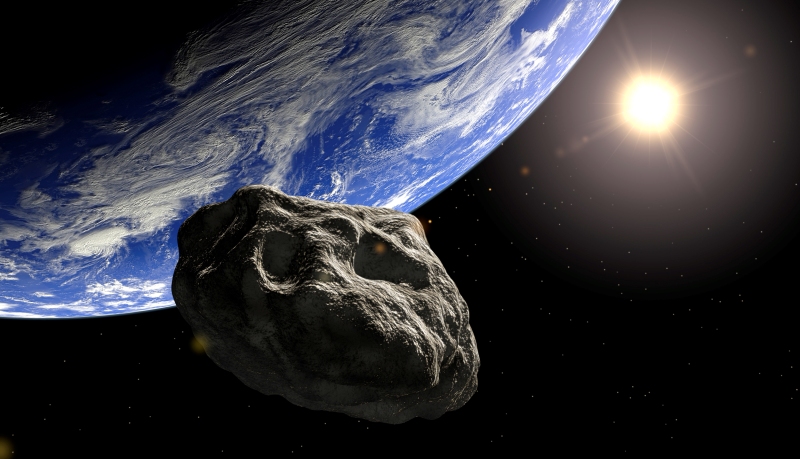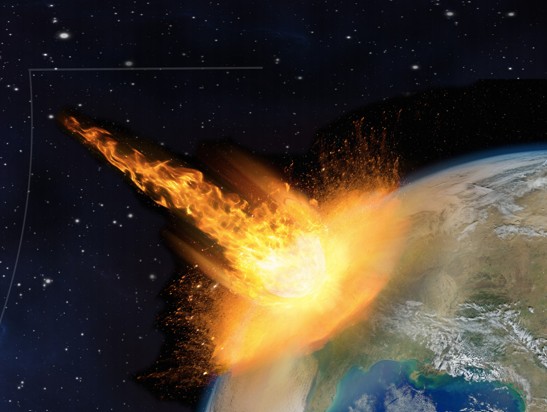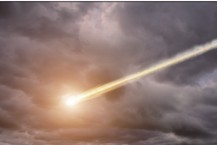
Think about the following questions.
1. What do you know about asteroids?
2. When was the last time a large rock from space or an asteroid hit Earth?
3. Should we be concerned about the chance of an asteroid hitting Earth in the future?
VOCABULARY PREVIEW
Match each New Academic Word List(NAWL) word with the correct definition.
- velocity
- atomic _____
- coordinates _____
- ton _____
- mineral _____
- sometime _____
- a. a unit of weight that equals 2,000 pounds
- b. a substance that is naturally formed under the ground
- c. at an unspecified time in the future
- d. speed
- e. a set of numbers used to locate a point on a map, graph, etc.
- f. of or relating to the energy that is produced when atoms are split apart
ASTEROID IMPACTS ON EARTH

Asteroids are small objects that orbit the Sun. They are small compared to the Earth and the other planets and are made of different kinds of minerals. Astronomers have mapped the coordinates of many asteroids, but not all. Though they may seem small and far away, asteroids have hit the Earth many times, sometimes causing extreme destruction1, and it seems clear that an asteroid will hit the Earth again in the future.
Most asteroids are located in what is called the asteroid belt or main belt, an area between Mars and Jupiter. All of these asteroids are very far from the Earth and will never come close. Several hundred asteroids, called trojans, follow Jupiter in its orbit, and asteroids can be found in the outer solar system as well, past the orbit of Saturn. Most importantly to humans, however, there is also a set of asteroids that orbit close to the Earth. These are called near-Earth asteroids (NEAs). NEAs are included in a group called near-Earth objects (NEOS), which also includes comets2 and meteoroids3. Because of their closeness, NEAs are dangerous to the Earth.
Most likely, only about half of all NEAs have been discovered. There is no way to predict when an asteroid could strike the Earth. In 1989, an NEA passed very close, but it was only discovered as it was going away. If it had hit the Earth, it would have been a catastrophic surprise, with 50,000 times the destructive force of the atomic bomb dropped on Hiroshima. Though the possibility of an asteroid striking the Earth soon is not great, it is almost certain that the Earth will be struck sometime.
NEAs have struck the Earth before, and in fact, most scientists believe that an asteroid caused the extinction of the dinosaurs. This sort of asteroid would have been one or more kilometers in diameter4. If it hit land—at a likely velocity of fifteen to twenty kilometers per second—it must have caused a huge cloud of dust that would have blocked out all sunlight for at least a year. This would have caused a short ice age, leading to the extinction of numerous plants and animals. If the asteroid hit water, which is more likely, the cloud of water vapor it produced would have had a similar effect. Further, the shock from the impact could have caused volcanoes to erupt, adding to the dust and vapor around the Earth. Scientists think these kinds of events happen every million years or so. The outlines of the craters5 of some of these impacts are still visible from space.
The last time a large NEA struck the Earth was in 1908, near the Podkamennaya Tunguska River in Siberia, Russia, in what became known as the Tunguska Event. The asteroid was between thirty and sixty meters across and exploded in the air instead of hitting the ground, causing an explosion equivalent to thirty million tons of TNT6. Fortunately, because the event occurred in a very remote place, no one was killed; however, hundreds of kilometers away, windows were smashed, and people could feel extreme heat. Vibrations7 were recorded in the earth as far as 1,000 kilometers away. The forest near the blast8 site had been flattened9 as far as thirty kilometers from the center, and some trees were burned completely. The asteroid itself had been entirely vaporized10.
Though people may worry about large asteroids striking the Earth, the large ones are easy to detect. Smaller NEAs are much harder to find, and there are many more of them. Clearly, the history of asteroids and the Earth is not over.
New Academic Word List
- destruction 1 : n. the act of damaging something so badly that it no longer exists or cannot be repaired
- comet 2 : n. an object in outer space made of ice and dust that develops a long bright tail when it passes near the Sun
- meteoroid 3 : n. a body moving in the solar system that is smaller than an asteroid and would become a meteor if it entered Earth's atmosphere
- diameter 4 : n. the distance through the center of something from one side to the other
- crater 5 : n. a large round hole in the ground made by something falling from the sky
- TNT 6 : n. a very powerful explosive
- vibration 7 : n. a continuous, slight shaking movement
- blast 8 : n. a powerful explosion
- flatten 9 : v. to knock down; to make flat
- vaporize 10 : v. to cause (something) to change into a vapor
READING COMPREHENSION
A ‣ Mark each statement as true (T) or false (F) according to the reading.
- Most asteroids are a long distance from Earth.
- True
- False
- Trojans are asteroids beyond Saturn's orbit.
- True
- False
- Scientists believe they have already found most NEAs.
- True
- False
- In 1989, an NEA hit Earth.
- True
- False
- The Tunguska Event caused many deaths.
- True
- False
B ‣ Choose the best answer according to the reading.
- What is the main idea of the reading?
- a. Scientists have learned a lot from past asteroid impacts.
- b. A future asteroid impact could wipe out all life on this planet.
- c. Asteroid impacts have affected Earth in the past and will again.
- d. Most asteroid impacts in the past have not been very large.
- How could an asteroid have caused the extinction of the dinosaurs?
- a. By hitting the dinosaurs
- b. By making a poisonous vapor
- c. By changing the climate
- d. By causing volcanoes to erupt
- Which is NOT true about the Tunguska Event?
- a. It broke windows hundreds of kilometers away.
- b. The object was found in a Siberian forest.
- c. The object was not more than sixty meters wide.
- d. It happened far from where people lived.
- What can be inferred from the last paragraph?
- a. Small NEAs are a greater cause for concern than large ones.
- b. Scientists have very little interest in small NEAs.
- c. Scientists are close to identifying all NEAs.
- d. The next asteroid that hits Earth will probably be very large.
C ‣ Look for the answers in the reading and write them on the lines.
- main belt:
_____ - trojan:
_____ - Tunguska Event:
_____
SUMMARY
Fill in the blanks with the phrases in the box.
- dinosaurs' extinction
- impossible to know
- strike Earth
- small objects
- thirty million tons
- half of them
Asteroids are 1 _____ orbiting the Sun. Most are far from Earth, but some are close enough to 2 _____ someday. These are called near-Earth asteroids, or NEAs. Only about 3 _____ have probably been discovered. There have been asteroid impacts on Earth in the past. One of them probably led to the 4 _____ by causing an ice age. The most recent asteroid impact was the Tunguska Event in 1908. It had the same force as 5 _____ of TNT, but luckily, no one was killed. There will be more impacts in the future, but it is 6 _____ when.
VOCABULARY PRACTICE
Fill in the blanks with the words in the box. Change the form if necessary.
- mineral
- ton
- atomic
- sometime
- velocity
- coordinates
- The largest animal on Earth, the blue whale, weighs about 210 _____.
- Quartz is a(n) _____ that is found in sand and is also used in jewelry.
- Thanks to GPS, the lost hikers were able to report their _____ to help rescuers find them.
- I always said I would try scuba diving _____ , and now I'm finally doing it.
- _____ energy plants are generally very safe, but people are still afraid to live near them.
- If you drop an object from a high place, its _____ will increase as it falls.
SUPPLEMENTAL READING
It's All in the Location

Different kinds of NEAS can produce different kinds of damage. The kind of damage depends partly on the size and speed of the asteroid. However, it also depends on where the asteroid hits. An asteroid that hits the ocean will have a very different effect than one that strikes the land.
An asteroid that hits the water would produce the most destruction. While an asteroid hitting land. would cause damage in only one place, an ocean strike would cause a tsunami (a giant wave), which could severely damage or destroy cities close to the ocean over a very large area. Seventy percent of the Earth is covered by oceans, so an ocean impact is more likely. If a large asteroid struck the middle of the Atlantic Ocean, the tsunami could destroy cities on the east coast of North and South America, as well as the western cities of Europe and Africa. Such an asteroid would only have to be about forty to sixty meters wide.
An asteroid strike on land would be destructive in a concentrated way. It would take an object about seventy-five meters wide to destroy a city. This would not include all parts of the city, and suburbs might not be damaged so severely. To destroy an entire urban area would take an asteroid of around 160 meters. A 700-meter asteroid could destroy a small country. However, an asteroid a kilometer wide would be deadly enough to kill millions of people simply by the dust and vapor it would throw into the atmosphere.
Fill in the blanks with information from the reading.
- Asteroids cause more _____ when they strike water than when they strike land.
- An asteroid that struck the Atlantic Ocean would cause a(n) _____ that could destroy cities on four continents.
- A whole small country could be damaged by a(n) _____ asteroid.

Leave a comment
Load more